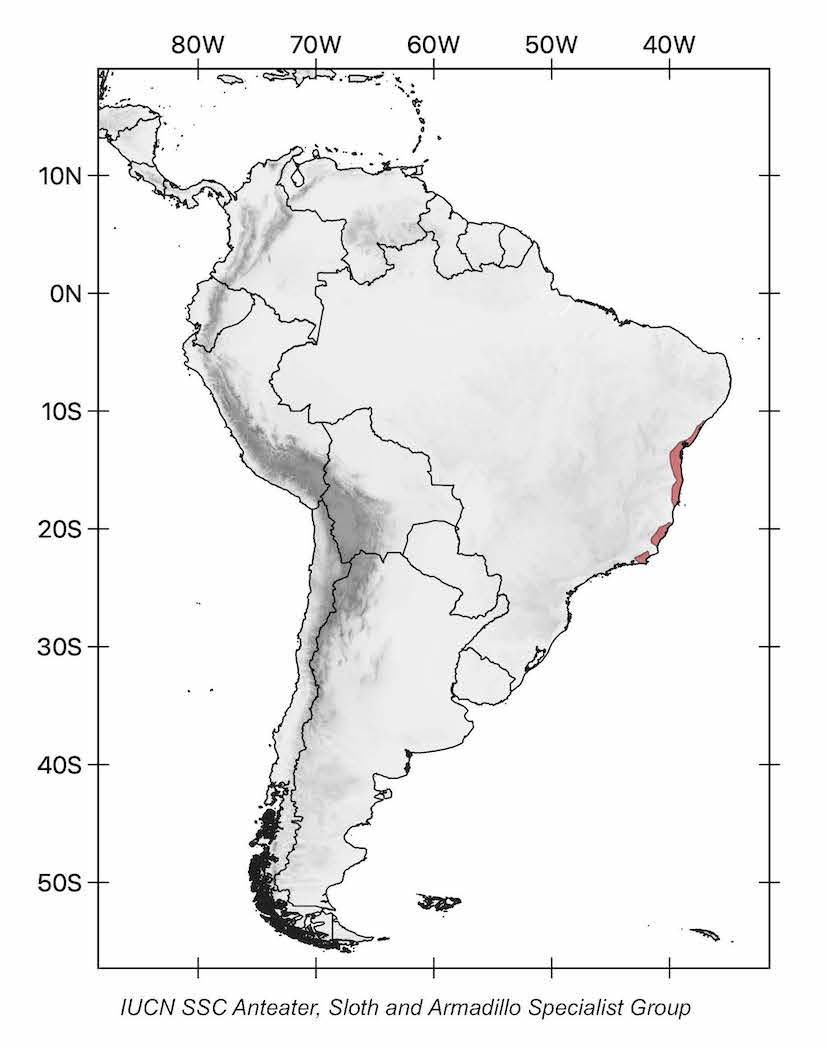Maned sloth
(Bradypus torquatus)
other common names
Maned three-toed sloth
Brazilian three-toed sloth
Taxonomy
Order: Pilosa
Family: Bradypodidae


description
This sloth has a head-body length of 59–75 cm and a short tail of 4–5 cm. It weighs around 4.6–10.1 kg. Male maned sloths are smaller than females. The fur is brown with long, coarse hair that is often colonized by algae. Both males and females have black manes around the dorsal region of the neck, which are longer and darker in males.

diet
This is a strict folivore that feeds on a relatively small number of food plants. One study found that leaves from 21 species formed 99% of the diet of three animals.

reproduction
The females give birth to a single young per year. Most births occur at the end of the wet season and beginning of the dry season (February-April). Sexual maturity is probably reached between the second and third year.

range
Bradypus torquatus is restricted to the Atlantic coastal forests of eastern Brazil, where its range is discontinuous. At present, the southern part of the state of Bahia is the primary stronghold for the species. Recent records have confirmed the species in the state of Sergipe. Its northern distribution is currently delimited by the Vaza-Barris River, in the coastal Atlantic forest of central-southern Sergipe. The southernmost part of the distribution corresponds to the north-central portion of Rio de Janeiro. A natural biogeographic gap occurs in northern Espírito Santo, from the left bank of Doce River in Espírito Santo to the vicinity of Mucuri River in southern Bahia. A second, smaller, gap occurs between southern Espírito Santo and northern Rio de Janeiro states.

curious facts
Unlike other Bradypus species, male maned sloths do not have a dorsal speculum, but they have long black manes.

Population trend
Decreasing.

HaBITAT and ECOLOGy
This largely arboreal species is found in wet tropical forest. Most records are from evergreen forests, and just a handful of sightings are from semi-deciduous forests. It can be found in regenerating secondary forests and shady agroecosystems, such as cabrucas (cocoa plantation under native forest in southern Bahia). Maned sloths are active at day and at night, although more regular activity occurs during the day. However, in some areas, such as Poço das Antas Biological Reserve in Rio de Janeiro State, maned sloths are mainly active at night. Maned sloths climb slowly and positioning themselves on undersides of branches. They move, on average, only 17 m during the day and 5 m at night. The longest single movement that has been recorded of a maned sloth was more than 300 m in 5.5 hours. Home ranges have been estimated at 2.8–5.9 ha. Longevity in the wild is at least 12 years.

threats
The expansion of agricultural areas, pasturelands, and urban sprawl—with the consequent habitat loss—are the main threats to the species. The rate of deforestation in the Atlantic forest of eastern Brazil has decreased dramatically in the last three decades but has not stopped, so the pressure on habitat continues. This is particularly true in the northern states of Bahia and Sergipe, where illegal or unregulated deforestation for several reasons, including agriculture expansion (especially pasturelands), urban sprawl and coal production, is still taking place. The genetic integrity of distinct populations is threatened by the release of confiscated animals at different sites without knowledge or understanding of their origins. Additional threats include subsistence hunting, use in traditional medicine and accidental mortality of B. torquatus on roads. In fact, roadkill might be considered a growing impact due to road expansion or duplication. Bradypus torquatus, and especially the subpopulations of Espírito Santo and Rio de Janeiro, is affected by the increased seasonality and prolonged droughts. These threats could become more intense due to climate change.

conservation status
Bradypus torquatus is listed as Vulnerable because it has a restricted area of occupancy (i.e. area of suitable habitat), which is probably less than 1,000 km² based on remaining forest within its highly fragmented range. Its area of occupancy and habitat are in continuing decline due to ongoing habitat loss and degradation in the Brazilian Atlantic Forest. Furthermore, this species, like all sloths, is susceptible to roadkill, a growing impact considering current and future city sprawl and road development in the region of the Atlantic forest occupied by the species. Poaching or capture for the illegal animal trade might be minor threats whose impact, nevertheless, should not be ignored, particularly in smaller forest fragments where the population is down to a few individuals.